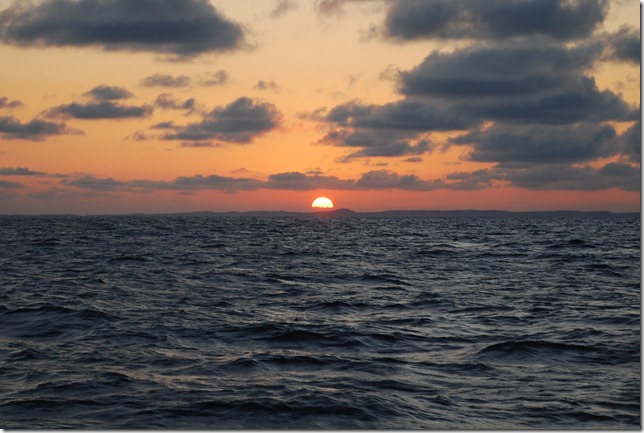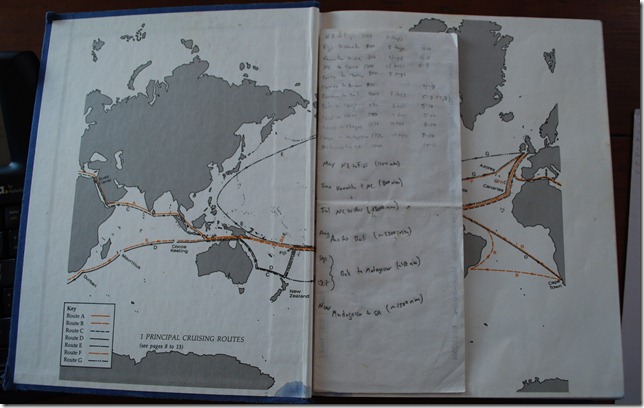Lat: 25 28.947′ S
Lon: 33 46.086′ E
This five day weather window has been without contrary winds, but the winds we have had have generally been pretty light. If we’d taken what the winds gave us, we’d be anchoring in Inhambane, two weather windows and probably two weeks away from South Africa. Instead, we’ve made liberal use of the D-Sail (diesel engines) to motor and motor-sail our way south. At this point, we’re set to reach Inhaca (in-YOK-uh) Island, near the Mozambique capital Maputo, just after sunset tonight, right before strong southerlies begin blowing. We were hoping to find a helpful current along the Mozambique coast once we reached the Bazaruto Archipelago, but if anything we seemed to have a bit of a counter current. When we finally sailed closer to the coast to “turn the corner” toward Inhaca and reached depths of 600 ft or so we found a southbound current of 0.5-1.0 knot or so that has stayed with us until now, and it seems to be turning south as we make our way farther west. With the light and variable winds, sail changes happen several times a day, with the main going up and down, the jib in and out, and yesterday the spinnaker even made an appearance for a few hours.
Most mornings have started with several squalls and light, cool westerly breezes off the land. Both dissipate about the time Lauren gets up, leading me to joke with her that the sun here waits for her to get up. We’ve enjoyed starting the day with fresh mangos and pineapple from Quelimane and since we reached Bazaruto, where we’ve sailed closer to the coast, seeing dolphins has been at least a once daily occurrence. They’ve been playful as usual, but yesterday’s batch were a little odd. They were smaller than the dolphins we’re used to seeing and instead of fully clearing the water in graceful arcs or leaps, they just jumped out sort of lazily until all of their body except the tail was nearly vertical and out of the water and then fell back onto the surface, landing on their sides with a flop. It looked more like the flops whales make than what we’re used to seeing dolphins do.
The days have been a mixed bag of overcast and temperate with enough wind to sail or clear and hot with very light winds. With such light winds, the wind-driven waves are almost nothing but the sea has never been flat. A slow, rolling, and sometimes large swell from the southwest serves as a reminder that that are some big winds over the horizon in the Southern Ocean with no buffering land mass between us.
 Sun setting over the Mozambique coast as we sail south close to shore
Sun setting over the Mozambique coast as we sail south close to shore
We’re nearing the end of a stretch where we’ve covered 8000 nm between Cairns, Australia and South Africa in 4 months, and we’re definitely looking forward to only having to cover 700-800 miles of South African coast in the next two months. Even though it’s the most dangerous area we’ll have to sail in from a weather perspective, we have the time to pick good weather windows and enjoy plenty of time ashore in an interesting place.
With just the two of us aboard, we’ve had a lot of time to reflect on the trip and how it has impacted us as a couple. Living in such close proximity to others when there were 4-6 of us, dealing with the needs of the boat, trip, and crew on a daily basis, and then sailing 8000 miles in 4 months with only infrequent contact with other people definitely puts some strain on a relationship in a way that most lifestyles don’t. On the other hand, we’ve enjoyed some incredible experiences together, done something that few people have the opportunity to do, and had the time for days filled with conversations and reflection. From what we’ve observed, it does seem like sailing at this pace is a bit easier for couples who have been together longer and have a better idea of who their partner is and how they relate to each other than it is for newer couples still learning about each other and their relationship and finding that they’re getting an opportunity to do that in a much more intimate and sometimes intense setting than they could ever imagine.
I remember the first circumnavigation that I followed online in the mid 90’s. It was a middle-aged but relatively new couple from Houston sailing a small, traditional boat via the Panama and Suez canals on a 2 year itinerary. Somewhere in Asia, the man wrote on the website that his partner had left for a stint back in the states and he didn’t know when or if she would return. If I remember right, she returned somewhere near Singapore or Thailand. I remember seeing the boat back in Houston after their return and being surprised by its small size, cluttered decks, and the broker’s comment that after 2 years at sea the boat stank. It definitely put some reality alongside the glossy cruising magazines.
In New Zealand, I spent a fair amount of time with Jimmy Cornell’s “World Cruising Routes”, working out on a piece of paper the distances, passage times, and optimal months for covering the distance between New Zealand and South Africa. The itinerary I worked out on it has been been our guide since then and the last line (Nov Madagascar to SA (~1500 nm)) is becoming obsolete more or less on schedule. It’s really amazing to take that piece of paper from inside the cover of the book and to look at it now. Something that seemed so daunting and unimaginable just 6 months ago is now nearly complete. Today I started another piece of paper for the Atlantic — South Africa to Florida. The South Atlantic should be a much friendlier bit of sailing and after crossing two oceans, the third doesn’t seem quite as daunting. The distance from the BVI to Florida, about 1100 nm, used to seem huge, but now it’s going to feel like we’re right next door to the Florida coast that we sailed from Amelia Island down to Key West before setting sail for Panama 19 months ago.
 Inside cover of Cornell’s “World Cruising Routes” with the itinerary I originally worked out in New Zealand
Inside cover of Cornell’s “World Cruising Routes” with the itinerary I originally worked out in New Zealand

